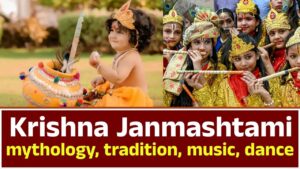Photo Krishna Janmashtami
Introduction
Krishna Janmashtami is one of the most joyous and spiritually uplifting festivals in Hinduism, celebrated to mark the birth of Lord Krishna, the eighth incarnation of Lord Vishnu. Observed with great devotion across India and in many parts of the world, this festival is a blend of mythology, tradition, music, dance, fasting, and community celebrations.

Falling on the eighth day (Ashtami) of the Krishna Paksha in the month of Bhadrapada (August–September), Janmashtami brings together millions of devotees who stay up till midnight — the divine hour of Krishna’s birth — to sing bhajans, enact scenes from his childhood, and offer prayers.
🎉 Krishna Janmashtami Baby Photo Contest 🎉
Mythological Background
The roots of Krishna Janmashtami lie in the Bhagavata Purana, Vishnu Purana, and the Harivamsa section of the Mahabharata. According to legend, the evil King Kansa of Mathura heard a prophecy that his sister Devaki’s eighth child would be his killer. Out of fear, Kansa imprisoned Devaki and her husband Vasudeva, killing each of their first seven children at birth.
When the eighth child — Krishna — was born at midnight, the prison guards mysteriously fell asleep, and the doors of the cell opened. A divine voice instructed Vasudeva to carry the newborn across the stormy Yamuna River to the safety of Gokul, where the child would be raised by Nanda and Yashoda. This miraculous escape set the stage for Krishna’s childhood filled with playful acts, divine miracles, and ultimately, the downfall of Kansa.
Symbolism of Krishna’s Birth
Every element of Krishna’s birth story holds deep symbolic meaning:
- Darkness of midnight – The birth of divine light in a world clouded by ignorance.
- Prison – The human mind trapped in ego and material desires.
- Crossing the Yamuna – Overcoming obstacles with faith and devotion.
- Gokul – The pure, innocent heart where God resides.
Determining the Date
The date of Janmashtami changes each year based on the lunar calendar. It is observed on the Ashtami Tithi of the Krishna Paksha in the month of Bhadrapada. Astronomers and priests also consider the Rohini Nakshatra (Krishna’s birth star) for accurate timing. The festival often spans two days — one for Smarta tradition and one for Vaishnava tradition.
Preparations
Weeks before the festival, homes and temples are cleaned and decorated with flowers, mango leaves, and lights. Idols of baby Krishna are polished, dressed in new clothes, and adorned with jewels. Streets are lined with colorful banners announcing Dahi Handi competitions and Rasa Lila performances.
Rituals of Janmashtami
The celebration follows a well-structured sequence:
Morning
- Devotees begin the day with a ritual bath and wear clean or traditional clothes.
- Temples and homes are decorated.
- A small cradle is prepared for the baby Krishna idol.
Fasting (Vrat)
- Many observe Nirjala Vrat (without food and water) or Phalahar Vrat (fruit and milk only).
- The fast continues until midnight, broken after the birth celebrations.
Evening Puja
- Devotees gather for bhajans and kirtans praising Krishna.
- Scriptural readings from the Bhagavad Gita and Bhagavata Purana are held.
Abhishekam (Bathing the Deity)
- At midnight, the Krishna idol is bathed in panchamrit (a mixture of milk, curd, honey, ghee, and sugar).
- The idol is then dressed in beautiful clothes and placed in the decorated cradle.
Midnight Celebrations
- Conch shells are blown, bells ring, and devotees chant “Hare Krishna, Hare Rama.”
- Prasad is distributed, and the fast is broken.
Regional Celebrations
- Mathura & Vrindavan – The epicenter of Janmashtami celebrations with temple processions, Rasa Lila plays, and massive gatherings.
- Maharashtra – Famous for Dahi Handi, where youth form human pyramids to break a pot of curd tied high above the ground.
- Gujarat (Dwarka) – Krishna’s kingdom celebrates with sea-side temple processions.
- South India – Homes create floor art of tiny footprints symbolizing Krishna’s arrival.
- North East (Manipur) – Devotional music and Vaishnava traditions flourish.
- ISKCON Temples Worldwide – Celebrations with 24-hour kirtans, vegetarian feasts, and dramas.
Cultural Events
The festival blends devotion with cultural expression:
- Rasa Lila – Theatrical performances of Krishna’s life and dance with the gopis.
- Bhajans & Kirtans – Soulful devotional songs often lasting all night.
- Dahi Handi Competitions – Youth groups known as Govindas compete to form the tallest human pyramid.
Traditional Foods
Offerings (Naivedya) to Krishna include:
- Makhan Mishri – Butter mixed with sugar crystals.
- Panjiri – Sweet made with whole wheat flour, ghee, and dry fruits.
- Kheer – Rice pudding with milk and sugar.
- Malpua, Peda, Ladoo – Rich sweets for prasad.
- Fasting Foods – Sabudana khichdi, fruits, milk-based dishes.
Philosophical Teachings
Krishna’s life is filled with spiritual lessons:
- Dharma over fear – As shown in the Bhagavad Gita.
- Detachment in action – Perform duty without attachment to results.
- Love without conditions – Krishna’s bond with Radha and the gopis.
- Unity through devotion – Bhakti transcends caste, creed, and status.
Modern-Day Significance
In cities, Janmashtami is celebrated with televised events, community gatherings, and charity drives. Social media streams live temple rituals, allowing devotees worldwide to participate.
Economic & Tourism Impact
Janmashtami draws lakhs of pilgrims to Mathura, Vrindavan, and Dwarka, boosting local economies through temple donations, handicrafts, sweets, and tourism services.
Spiritual Benefits
- Purifies the heart and mind.
- Strengthens discipline and self-control through fasting.
- Deepens devotion and connection to God.
Conclusion
Krishna Janmashtami is more than just a festival — it’s a reminder that in times of darkness, divine light always prevails. Whether celebrated with grand temple processions or a simple home puja, the essence remains the same: love, devotion, and joy in remembering Lord Krishna.
